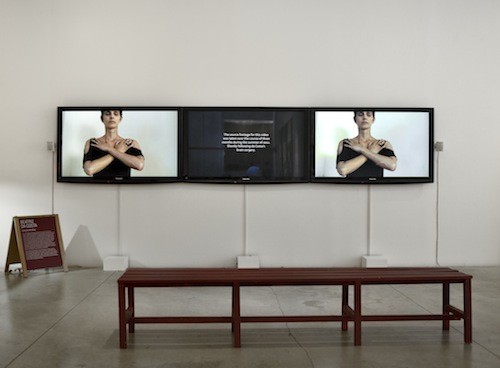
Beatriz da Costa. “Dying for the Other,” 2011. Installed at the Sheila C. Johnson Design Center Parsons The New School for Design.
How does one continue an artist’s work posthumously?
I began working as Beatriz da Costa’s assistant about six months before she passed away. We met not long after she had undergone surgery to remove tumors that had spread from her breasts to her brain. Because Beatriz was dealing with the side effects of surgery, and medications that often left her sick and exhausted, her bedroom quickly became our studio. “Who knows what will happen a month from now,” she once told me.
To work this way, never knowing when Beatriz’s life might come to an end, was strangely uncanny. I had watched my father die from cancer too, succumbing only six months after his diagnosis. Knowing that Beatriz was ill, I tried to mentally prepare myself, but my close experience with cancer would still embroil me in our work together and partnership as artists.
Beatriz passed a few days after last Christmas. We had just launched a RocketHub crowdfunding campaign for her Anti-Cancer Survival Kit, a multimedia package for “people living with cancer, their family and friends, and those who never wish to get cancer in the first place.” The kit was motivated by Beatriz’s own experiences and desire to share information that she wished she’d received earlier on. As she envisioned it, the kit would consist of a coffee-table-style artist book with illustrations; an e-book designed to reach wider audiences; a comprehensive database of scientific articles; a reference guide; educational games for mobile devices; a DIY anti-cancer garden; an assortment of practical and feel good items such as teas and chocolates; and a wooden crate to hold everything.
Beatriz da Costa leads her Anti-Cancer Gardening Workshop, 2012.
Following her memorials in New York and Germany, donations for the Anti-Cancer Survival Kit began to pour in; the campaign closed successfully in February. Beatriz’s team of assistants and collaborators regrouped to push the project forward, but no roadmap or playbook had been left behind. All we had were our emails and notes, memories and impressions, and individual ideas about how the kit would exist in the world. What had once seemed so clear now prompted questions and stirred uncertainties.
Pamela Mendoza, Johnny Lu, Donald Daedalus and I met with Beatriz’s partner, Robert Nideffer, and we began to assemble the kit collectively. From the cutting boards and crates to the e-book and iPad game, most decisions about the different components were made by consensus. Design was easy since the graphic elements had been determined before Beatriz passed. Printed materials such as the book and reference guide have proven most difficult and continue to be in the idea phase. For the book, we have only a preliminary table of contents and some notes on Google Drive. Frank Peter, who had already signed on to co-write the book, continues to work with us on its development.
As the kit was coming together, I began organizing ex·pose, a solo exhibition of Beatriz’s work at the Laguna Art Museum. Beatriz had introduced me to curator Grace Kook-Anderson, informing her that my role in the show would be significant. (Beatriz was always generous about crediting others.) In the past, we had always negotiated our ideas, but installing ex·pose required me to make decisions on my own—and my practice is quite different from Beatriz’s. She had told me more than once to be “bolder,” to own my ideas and stand behind my work and choices. But how could I position myself in the conceptual space from which she operated? Where would I insert Beatriz’s voice versus my own? I kept coming back to questions of stewardship and responsibility, and the blurring lines between collaboration and ownership in her absence.
One afternoon I received a call from Grace who was seeking direction on how to display the items in the kit. We agreed to place many of them in vitrines, a decision that still bothers me. It occurred to me later that securing the items under plexiglass was at odds with one of Beatriz’s core objectives: public engagement. So I decided to include the Anti-Cancer database on a centrally-located laptop and a beta version of the Anti-Cancer game on an iPad. Grace, perhaps also sensing the tension between the vitrined display and Beatriz’s intentions, created a space where visitors could share their personal experiences with cancer by writing their stories on Post-it Notes and sticking them to a gallery wall. For me, there was an important lesson in these later decisions: there can be multiple ways to carry out an artist’s vision after he or she has passed.
Interactive installation in “expose: beatriz da costa” at the Laguna Art Museum, 2013. Courtesy Crys Moore.
Working on the Anti-Cancer Survival Kit has been an incredible experience, one that has positively and deeply affected my life. And now that the project exists outside of the studio, it can affect the lives of others—just as Beatriz wanted.
____________
Crys Moore is a multimedia artist and recent graduate of New York University’s Interactive Telecommunications Program, where she will begin a research residency in the fall. ex·pose: beatriz da costa is on view at the Laguna Art Museum, June 2 – September 29, 2013. Moore will give a public tour of the exhibition on June 16.